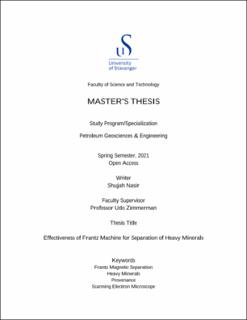| dc.description.abstract | This project research the provenance of Precambrian formations: Vredefontein Formation, Grootderm Formation, and Derburg Formation from Namibia. The aim is to enhance provenance understanding after the separation of minerals with the Frantz Magnetic Separator. The results obtained from the magnetic separator were also matched with Scanning Electron Microscope and X-Ray Diffraction (XRD).
The rock samples were mainly lavas and gabbro. So, we had both types of rocks (Plutonic and Volcanic). Gabbro is observed mainly with pyroxenes, amphiboles, and plagioclase. The Vredenfontein Formation contains mostly albites, hematite, microcline, and sanidine. Important minerals include apatite and zircons in Vredefontein Formation. Major minerals in the Grootderm Formation are epidotes, chlorites, and lawsonites.
Samples were sieved into fractions of different sizes and then those fractions were analyzed through Frantz Separator. Mounts were prepared and epoxied. The EDS spectra were obtained from SEM and are then identified for the minerals and are matched with XRD spectrums. The XRD graphs were obtained on low intensity but showed major minerals in rock samples. Minerals were separated in Frantz according to their magnetic susceptibilities which can be further used in hydrocarbon industry and mineral industry. | |
